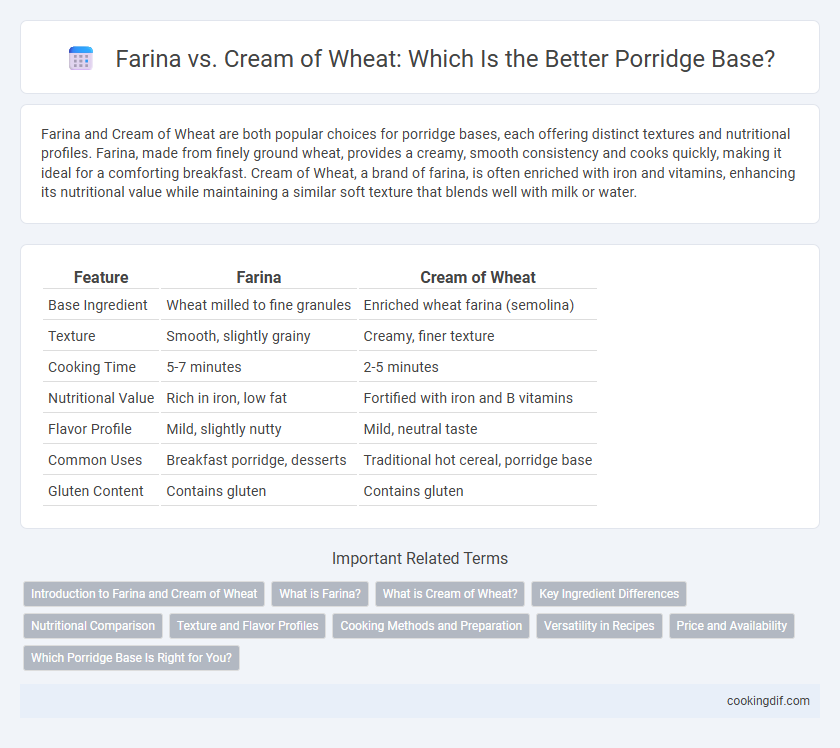Farina and Cream of Wheat are both popular choices for porridge bases, each offering distinct textures and nutritional profiles. Farina, made from finely ground wheat, provides a creamy, smooth consistency and cooks quickly, making it ideal for a comforting breakfast. Cream of Wheat, a brand of farina, is often enriched with iron and vitamins, enhancing its nutritional value while maintaining a similar soft texture that blends well with milk or water.
Table of Comparison
| Feature | Farina | Cream of Wheat |
|---|---|---|
| Base Ingredient | Wheat milled to fine granules | Enriched wheat farina (semolina) |
| Texture | Smooth, slightly grainy | Creamy, finer texture |
| Cooking Time | 5-7 minutes | 2-5 minutes |
| Nutritional Value | Rich in iron, low fat | Fortified with iron and B vitamins |
| Flavor Profile | Mild, slightly nutty | Mild, neutral taste |
| Common Uses | Breakfast porridge, desserts | Traditional hot cereal, porridge base |
| Gluten Content | Contains gluten | Contains gluten |
Introduction to Farina and Cream of Wheat
Farina, a milled wheat product, offers a fine texture and mild flavor, making it a popular base for porridge that cooks quickly and absorbs liquids well. Cream of Wheat, a refined farina grain, provides a smoother consistency and often enriches porridge with added vitamins and minerals like iron and calcium. Both serve as excellent porridge bases, with Farina delivering a heartier bite and Cream of Wheat favored for its creamy, velvety texture.
What is Farina?
Farina, a type of milled wheat often used as a porridge base, is coarsely ground from the endosperm of wheat kernels, providing a smooth, creamy texture when cooked. Unlike Cream of Wheat, which is a brand name for a similar milled wheat cereal with a finer texture and enriched with iron and B vitamins, Farina remains a versatile and minimally processed option. Its high carbohydrate content and low fat make Farina a popular choice for a warm, easily digestible breakfast porridge.
What is Cream of Wheat?
Cream of Wheat is a finely ground wheat semolina cereal known for its smooth texture and quick cooking time, making it an ideal base for porridge. It is fortified with essential nutrients like iron and B vitamins, providing a nutritious option compared to traditional farina. Its mild flavor and creamy consistency make it versatile for both sweet and savory porridge recipes.
Key Ingredient Differences
Farina and Cream of Wheat both serve as smooth, creamy porridge bases but differ primarily in their grain processing and nutritional profiles. Farina is made from milled wheat kernels, often enriched with iron and B vitamins, providing a slightly coarser texture and nuttier flavor compared to the finely ground, smooth consistency of Cream of Wheat. The key ingredient differences impact cooking time, texture, and nutrient content, making Farina higher in fiber while Cream of Wheat offers quicker preparation and a mild taste suitable for versatile flavor pairings.
Nutritional Comparison
Farina and Cream of Wheat both serve as popular bases for porridge, with farina typically offering slightly higher fiber content due to its whole grain composition, while Cream of Wheat is made from enriched wheat semolina, providing essential nutrients like iron and B vitamins. Farina contains around 100 calories and 3 grams of protein per half-cup serving, whereas Cream of Wheat delivers approximately 120 calories and 4 grams of protein for the same portion. Both options are low in fat and sugars but differ in their glycemic index, with Cream of Wheat having a moderately higher impact on blood sugar levels compared to farina.
Texture and Flavor Profiles
Farina offers a smooth, creamy texture with a mild, slightly nutty flavor that blends well with both sweet and savory toppings. Cream of Wheat provides a denser, silkier consistency and a more neutral, subtly wheaty taste that enhances the porridge's overall richness. Both bases cook quickly but Farina tends to be more delicate, while Cream of Wheat holds its shape better for a heartier mouthfeel.
Cooking Methods and Preparation
Farina cooks quickly with a smooth, creamy texture achieved by gradually whisking it into boiling water or milk, making it ideal for fast, stovetop preparation. Cream of Wheat requires constant stirring during cooking to prevent lumps and achieve its signature velvety consistency, often simmered over low heat for 3 to 5 minutes. Both porridges benefit from slow incorporation of liquid to avoid clumping, but Farina's finer grain structure results in a less thick, more delicate porridge than the slightly heartier texture of Cream of Wheat.
Versatility in Recipes
Farina offers greater versatility in porridge recipes due to its finer texture and neutral flavor, allowing easy incorporation of both sweet and savory ingredients. Cream of wheat, while smooth and creamy, tends to pair best with sweet additions such as fruits and honey, limiting its range in savory dishes. Home cooks often prefer farina for experimental recipes like vegetable porridge or spiced bowls, making it a more adaptable porridge base.
Price and Availability
Farina and Cream of Wheat are both affordable options for porridge, but Farina generally costs slightly less due to its simpler production process. Cream of Wheat tends to be more widely available in supermarkets across the US and Canada, benefiting from its established brand presence. Consumers seeking budget-friendly choices with easy access often prefer Farina, while those looking for variety in texture and flavor may opt for Cream of Wheat despite marginally higher prices.
Which Porridge Base Is Right for You?
Farina and Cream of Wheat are both popular porridge bases, each offering distinct textures and nutritional benefits. Farina, made from milled wheat, provides a smoother, creamier consistency rich in iron and B vitamins, making it ideal for those seeking quick, nutritious breakfasts. Cream of Wheat, often enriched with extra vitamins and minerals, cooks faster and has a finer texture, appealing to individuals who prefer light, easily digestible porridge.
Farina vs cream of wheat for porridge base Infographic

 cookingdif.com
cookingdif.com